|
|
Bride of Horror List
|
||||||||||||||||||||||||||||||
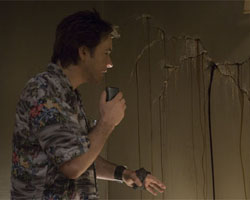 15) 1408
15) 1408Why it's on the list: You like the idea of those ghost hunters getting what they finally deserve. Why you might be saying "Oh, hell no!": You were told there would be no math on this list. --John Cusack trapped in a hotel room with no chance of escape; it might sound like one of your late-night fantasies, but it's actually the exceedingly simple plot concept behind one of the most surprising movies of the last several years. I saw 1408 mostly by accident, but it turned out to be a blissfully happy accident, as the film is utterly gripping. Based on a short story by Stephen King, the film is so tightly paced that it somehow manages to turn a very simple story into a thoroughly compelling adventure. You'd think that endless variations on "scary things happen to John Cusack in a hotel room" would get old after a while, but the creativity exhibited in the construction of the film, as well as Cusack's fine performance, keeps the story moving and the audience on its toes. Most importantly, because we actually care about the protagonist (which is not true of close to 100% of torture porn), we are drawn into the story, and then actually scared! A horror movie that does more than make us jump with loud noises and gross images? Shocking, I know, but 1408 pulls it off. (Tom Houseman/BOP) --John Cusack seems such an unlikely actor to pop up in a horror film. Which is part of the reason why this film's chills are well-earned. With his smarts and his skepticism in tow, he makes it seem possible his character can survive the hotel room where so many have lost their lives and minds. When things start to go south, we are already well-invested in seeing him make it out. The first two-thirds of the film are masterful, the denouement less so. Best scene: Cusack waving at "someone" in the building across the way. (Brett Beach/BOP) --To my mind, this is the type of story where Stephen King is truly in his element. Everything about the tale is a bit subversive, straight down to the fact that 1+4+0+8 makes the haunted hotel room unlucky 13 on the 13th floor, even if the hotel manager lies and calls it the 14th floor. Of course, in a lesser work, I would be first in line to mock this as the only good idea in the piece, but 1408 suffers no such fate. It's an impressive story that parcels out the personal history of a non-believer, a professional skeptic who has ample reason to have lost his faith. To his surprise, he receives an invitation to stay in a haunted hotel room that has not been rented for decades. And he eventually discovers it was the room itself who invited him. Now THAT is a creepy concept. 1408 is more than this basic premise of "how does a skeptic react when faced with the unexplainable," though. The reveal that the writer, Mike Enslin, is a grieving father whose daughter's death wrecked his marriage as well as his psyche makes him relatable. It is used particularly well here in that his need to believe that his daughter found solace after death drives many of his actions in attempting to bring down 1408 from the inside. I particularly like that while true believers were all submissive, ceding to the room's demand to commit suicide, the skeptic fights back even as he realizes his entire world view is wrong. In looking at the entirety of BOP's new horror list, something that shines through is that we as a group prefer our horror to be psychological in tone. We seek out that brand of fiction wherein the hero repeatedly questions their own sanity; perhaps none of the 25 titles represents this quality more aptly than 1408. And I particularly like that this is not a ghost story per se. In fact, the premise of ghosts is dismissed out of hand. Instead, this is an exploration of the existence of true evil in the world as well as how it presents itself to those it deems most vulnerable to its whispers of madness. (David Mumpower/BOP) |
|
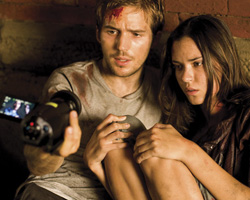 14) Cloverfield
14) CloverfieldWhy it's on the list: You always wanted to watch a Godzilla movie from the point-of-view of the trampled bystander. Why you might be saying "Oh, hell no!": You foolishly thought the Cloverfield monster might be in the movie for more than a glimpse. --Clever in both its concept (there is a specific structural reason the film can only be a mere 78 mins sans credits) and execution (intentionally keeping the film low budget can be more of an asset than a hindrance if done right), Cloverfield rises above its Felicity–meets-Godzilla premise to effectively capture the beauty and terror of full-scale destruction and a world committed to recording it all for posterity. Best scene: The money shot of Lady Liberty's severed head rolling through downtown. (Brett Beach/BOP) --To what degree could post-9/11 Americans tolerate seeing destruction rain down on New York City? When does shaky hand-held camera work become truly nauseating? What the hell is Slusho? J.J. Abrams and Matt Reeves put their stamp on the monster movie genre with 2008's Cloverfield, in which viewers are subjected to recovered film showing a rampaging beast tearing through NYC. We see carnage being wrought long before we ever catch a good glimpse of the monster responsible. And because the footage is shot by those fleeing the beast, we only get one or two good looks at the monster itself. The frames are filled with frenzied confusion and ruination as buildings are flattened, humans are squashed and national landmarks are utterly vandalized. We are racing along with the characters so quickly that we barely have time to question the rather bad decisions they make ("Quick, a dark subway tunnel! This way to safety!" or "I know, let's all go rescue Beth!") that will surely lessen their chances for survival. And the film contained enough Abrams-esque touches to keep audiences puzzling over clues (the Coney Island footage) long after the movie concluded. (Tony Kollath/BOP) --Jimmy Buffett always described his inebriated hook-up anthem, Why Don't We Get Drunk and Screw, as a love song from a different point of view. Similar terminology may be employed to describe Cloverfield as well. This is a Godzilla movie from a different point of view. In this instance, the focus is on the soon-to-be-trampled residents of a New York borough under attack from some sort of mutant alien or evolved Kraken or whatever. This single conceit reinvigorates the horror genre by building tension in an entirely new fashion. We are witness to a reality show where we have a sneaking suspicion that everyone involved will die. Except the monster. The beauty of this is the way that the viewer gets attached to characters like Hud, an amateur cinephile who carries a torch for distinctly unimpressed Marlena. We find ourselves caring for Rob and Beth, rooting for them to reveal their true feelings for one another, all the while knowing that Cloverfield is not that kind of movie. A happy ending is not just around the corner for any of the characters. Except the monster. I have stated in the past that I admire the cleverness of Cloverfield more than I love it as a movie. That remains the case. Even so, every time I watch another movie that enhances the ideas of Cloverfield (Quarantine being a blueprint example), it renews my conviction that Cloverfield is one of the best movie ideas of the 2000s, probably even one of the best ideas ever. This is the rarest of rare Hollywood dip of the toe in the lake of pure creativity. (David Mumpower/BOP) --One of the spiritual descendants of The Blair Witch Project, Cloverfield distinguished itself very quickly from the excessively stupid and stupidly excessive disaster films of the past two decades by jamming its characters right into the action. Made up entirely of "found" camcorder footage during an attack by some kind of Lovecraftian Godzilla monster on New York City, we get to follow four fairly non-descript 20-somethings as they try to venture to safety and/or loved ones within the city. Where the film succeeds best is in withholding information – we know only what our characters know and no more, and that's not much. Since the cataclysmic events take place over the course of one night, we are never quite sure what the nature of the threat is until the very end. Such a stylistic choice allows there to be tension in every scene since literally anything can happen at any point. Most of the horror is indirect and implied (though one character suffers what might be the worst fate in the history of cinema) and we're left with an altogether unsettling experience. (Reagen Sulewski/BOP) Cloverfield Trivia Quiz |
|
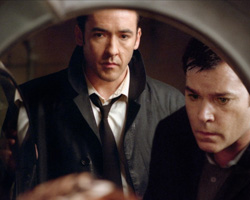 13) Identity
13) IdentityWhy it's on the list: We always knew that Lloyd Dobler was a whack job. Why you might be saying "Oh, hell no!": You hated the ending. --I'm always on the lookout for unique ideas in horror films, mostly because it's rare to find a truly unusual subject, or a distinctive take on a familiar subject. Identity is just such a film. There are so many reasons for this I have difficulty picking the highlights, but certainly one of the greatest is that, no matter how well you know the conventions of film in general and horror films in particular, you can't figure out what Identity's twist is until the film gets you there. Oh, sure; you think you know what you're getting, because Identity certainly starts you out on very familiar paths. But it's how the film walks you down those paths, and where you end up, that makes Identity such a great film, horror or otherwise. It's also one of those rare films that are difficult to talk about without giving perhaps too much away, and I wouldn't dream of taking away one scintilla of the fun for anyone who hasn't seen this film, and I would highly suggest you seek Identity out of your Halloween viewing. You won't be disappointed. (Stephanie Star Smith/BOP) --Who would ever have guessed that John Cusack might be the superstar member of our updated horror list? The affable actor who I have loved as Lloyd Dobler, Lane Meyer and Rob Gordon saw his career go to surprising places with Identity released in 2003 and 1408 hitting theaters in 2007. It's that easy identification with his lovable characters that makes us want to ride the scary roller coasters with him in these two horror films, and this particular quality is especially critical to the success of Identity. Although we'd think that people would learn not to stay at scary-looking, isolated motels that are off the beaten path, Identity nonetheless puts 10 strangers in one such location together...and soon starts killing them off, one by one. One of the guests must be the killer, right? The answer is not so simple, but the twists and turns taken by the script eventually lead to a big reveal that is ingeniously unpredictable. I can almost guarantee that you'll be very surprised by the resolution if you haven't seen the film already. Even if you're not really a big fan of scary movies, Identity is one that can work for people who just enjoy straight up thrillers, as long as you can handle a bit of slasher-style gore. (Kim Hollis/BOP) |
|
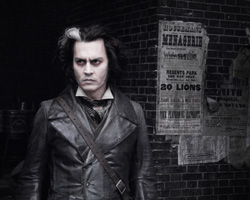 12) Sweeney Todd
12) Sweeney ToddWhy it's on the list: He turns Borat into meat pie. Talk about living the dream. Why you might be saying "Oh, hell no!": No one wants to know how the Chicken McNuggets get McNuggeted. --I was originally resistant to the idea of Sweeney Todd being considered a horror film. Oh, sure, it's dark, and Tim Burton did an excellent job of taking the seaminess of Victorian-era London and making it just that much darker and seamy, but that didn't make it a horror film, at least in my estimation. Then I started thinking about it and suddenly it dawned on me: My definition of what makes for a horror story was far too narrow. Because I realized that Edgar Allan Poe, arguably one of the greatest horror writers who ever lived and one of my favorites, trafficked not in ghosties and ghoulies and long-leggedly beasties and things that go bump in the night, but the blackness and blight of the human mind and spirit. And Sweeney Todd is unrelenting in its display of the absolute worst of man's inhumanity to man; in fact, there's almost no base human urge that one can think of that is not present Stephen Sondheim's musical, which Burton has wisely transported intact to the screen. As Sweeney Todd sings himself at the top of the film, the cruelty of man is as wondrous as Peru. And as frightening as any vampire or zombie or other monster. And then there's those meat pies. (Stephanie Star Smith/BOP) --This movie is the primary reason why I'm always afraid to eat at new restaurants. (David Mumpower/BOP) --If you're unfamiliar with the work of Stephen Sondheim, you might expect to go into this Johnny Depp musical to hear toe-tapping musical numbers with artfully choreographed dancing and spectacular set pieces. Well, if the set pieces part is important to you, you're in luck. Otherwise... Sweeney Todd is a classic revenge tale that has been told countless times and in a variety of ways, including stage plays, penny dreadful stories and eventually, a Tony Award-winning Broadway musical that first appeared in 1979. It was this musical that provided the inspiration for Tim Burton's disturbing movie adaptation, a movie so dark and distressing that it would find its way onto this new list of best horror. Depp portrays the titular character, of course, and it surely wouldn't be accurate to call him a hero. No, Sweeney Todd is a man bent on vengeance at all costs, and indeed by the end of the film, his eye-for-an-eye philosophy costs him dearly. The music actually adds to the atmosphere, as Sondheim's tunes are challenging and almost dissonant, qualities that work extremely well for the purposes of the highly unpleasant story unfolding around the characters. It's a nightmare version of the classic musical, and a story that explores the many facets of evil - from the corrupt Judge Turpin (Alan Rickman) to the conspiratorial and secret-keeping Mrs. Lovett to the fraud Adolfo Pirelli to Sweeney himself. I wasn't sure what to think of the film at the time, but the more I reflect on it, the more it seems to be the perfect film for this list. (Kim Hollis/BOP) |
|
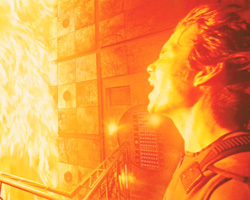 11) Sunshine
11) SunshineWhy it's on the list: Any film with a trailer that shows the death of every character is aces by us. Why you might be saying "Oh, hell no!": You didn't understand the ending. Don't worry. No one did. --This is the third time I've written about Danny Boyle's sci-fi/horror masterpiece, Sunshine, for BOP, and I doubt I'll ever run out of praise to lavish upon it. I first wrote about it as a great film ("Nothing short of a masterpiece.") and then as a great overlooked film ("A modern sci-fi classic [that] deserves to be recognized as the best film of 2007"), but now I'm going to look at it from a third perspective, which is Sunshine as a great horror film. The explanation for that title can be summed up in one word: tension. Danny Boyle's incredible talent shines (pun intended) in his abiilty to manipulate the emotions of the moviegoer. In Slumdog Millionaire he played our heartstrings like a banjo, but with Sunshine he grabs our heart and lungs and squeezes tight, never letting go for an instant. The tension constantly builds throughout the film, and with it the fear, until it explodes in an epic climax that shocks your entire system. Boyle didn't need blood and gore to make a great horror film, only a superb screenplay from Alex Garland, a number of great performances, and a superb sense of how to play his audience. That is why I first called Sunshine a masterpiece, and why I continue to defend that title to this day. (Tom Houseman/BOP) --Danny Boyle and Alex Garland reunited. A score by Underworld. A suicide mission to restart a dying sun. The elements are all here for a kick in the pants to the speculative fiction genre. The result is a confounding mashup of 2001 and The Towering Inferno. Too sincere to be easily dismissed, the movie misses its chance to go for the freak-out at the end and settles for being a more thoughtful Event Horizon. Best scene: Chris Evans sacrifices himself to save the ship and endures the O. Henry-ian irony of freezing to death on board instead of being burned up outside. (Brett Beach/BOP) --This list is published at roughly the same time as a NASA scientist has revealed a plan to launch a 100-year starship to Mars. This would be a one way trip, meaning that all of the people making the journey would be forced to say good-bye to their loved ones forever...or at least until someone significantly boosted the range of Wi-Fi. The symmetry of that announcement with the movie Sunshine is unmistakable. In Danny Boyle's taut drama, the Sun is dying and a group of heroes choose to sacrifice themselves in order to save the rest of the galaxy from doom. Their goal is to re-ignite the hottest celestial body, but all of the volunteers are aware that they are not the first such crew to attempt this journey. The first heroes never detonated their payload and never returned to Earth. Ergo, this is a story that has the claustrophobia of confined living quarters, the hopelessness of people accepting that their lives as they know it are over if they succeed, and the fear that their goal may prove impossible. And if they fail, this is the way the worlds end. Our vote reflects the fact that we believe Danny Boyle made an even scarier movie in this time frame. We mean that as a compliment. While Sunshine is an imperfect film whose final act is Paranormal Activity-ish in terms of satisfactory conclusion, there is simply no arguing the fact that getting there is a joy to watch. The journey the crew takes to arrive at the location wherein they release their payload is white knuckles, nails chewed, lower lip bitten until it bleeds tense and it features tremendous eye candy to boot. It's also a cautionary tale for would-be NASA explorers who only buy a one way ticket to Mars. (David Mumpower/BOP) |
|
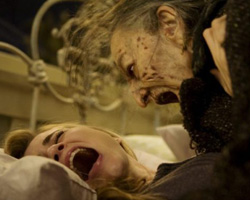 10) Drag Me to Hell
10) Drag Me to HellWhy it's on the list: We liked the specificity of the title. Why you might be saying "Oh, hell no!": You were annoyed by the specificity of the title. --I'll come right out and say it. After Spider-Man 2, this is Sam Raimi's best film. On one level, it's a hoot and a half with no airs or pretensions. Bearing the mark of someone who is relieved to have stepped away, however briefly, from $200 million dollar budgets, Raimi invigorates the "disreputable" genre in which he made his name and early fame. The energy, invention, wicked wit (love the possessed goat) and stylistic excesses of The Evil Dead films are on display. But then there's this...well, at the risk of uttering a dirty word...maturity to the proceedings as well. Raimi and his brother Ivan may not have been aiming for timeliness or allegory in their screenplay, but with a heroine in the mortgage industry who suffers mightily for evicting a Gypsy woman behind in her payments, it's hard not to see some ties to the real world financial woes. Ellen Page may have been the first choice for the lead role, but I find it hard to believe she could have matched Alison Lohan's warm smile in the opening half, feral gravedigging ferocity in the second half, and overall ability to be sprayed in blood, mud, and mucus and still bounce back for more. Christine Brown is flawed and all too human but the Raimis eschew a simple morality tale of comeuppance for something with a few more shades of gray. The first time I saw this I was confused by the sincerity of the romance between Lohman and Justin Long. I kept waiting for the other shoe to drop. Well, in the closing seconds it does. But not how I imagined it might. Some may quibble that all the good stuff (i.e. Hell) is kept offscreen and/or in short supply and that the ending is utterly predictable. I didn't see it coming. The closeup of Long's contorted face and tear-stained cheek is a bold final shot, designed to hit your heart and explode. Like the rest of the film, it succeeds. (Brett Beach/BOP) --After spending years making "serious" films and then becoming stuck with a certain web-slinger, Sam Raimi returned to his slapstick-horror roots with Drag Me to Hell and showed that he still has it. Coming at the height of the housing market crash, the story of a doe-eyed yet ambitious loan officer who is cursed by an old woman on whom she forecloses could perhaps have some sociopolitical undertones, but Raimi instead uses it as an opportunity to abuse his lead actress (a game Alison Lohman) to the delight of audiences. The film is filled with the customary Three Stooges influences and also contains a heavy dose of Looney Tunes (with a Wile E. Coyote-esque scene involving an anvil, even) to be high-energy, seat-squirming fun throughout. Dear Mr. Raimi, I'm sure that you like higher budgets and more prestige, but please try to continue to give us films like Drag Me to Hell now and again. (Dan Krovich/BOP) Drag Me to Hell Trivia Quiz |
|
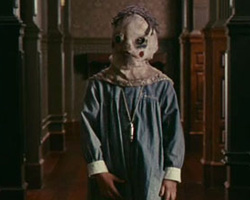 9) The Orphanage
9) The OrphanageWhy it's on the list: A scary movie with no horror movie cliches. How refreshing. Why you might be saying "Oh, hell no!": You're going to have to start taking your child's imaginary friend seriously. --Sometimes the simplest stories are the most powerful, and The Orphanage proves that adage. This Spanish horror film manages to deal with many complex themes in an honest way while simultaneously scaring your pants off. Guilt over losing a child, fear of the unknown, and faith in God are just a few of the ideas that Sergio Sanchez's script touches on as it creeps through a gripping story, and J.A. Bayona's superb direction creates an ambiance of pure terror as the suspense builds through this fantastic film. Creepy children, old secluded houses, conversations with ghosts; what doesn't this movie have? And yet its story and its themes feel so fresh and original, that it comes off as so much more than your run of the mill, old-fashioned pee yourself in fear horror film. (Tom Houseman/BOP) --When most people think of great horror movies, Psycho, Halloween and The Exorcist usually top the list. And while these are fine American choices, foreign horror films can often be just as indelible, sometimes more so. One of these is The Orphanage ("El orfanato) from Spain, which was presented to American audiences in late 2007 by the visionary filmmaker Guillermo del Toro, who seems to have an inherent sense for high quality. As good as it is, it's actually not the story of The Orphanage that makes it stand out as much as its style and visceral effect, including its heartrending emotion (rare for a horror movie). Still, the plot is not just a clothesline on which to hang startling images, but a fully realized story about a mother's love and determination to find her son after he goes missing. The action takes place at the same orphanage where the mother grew up and where she now suspects supernatural forces may have taken her child. This urges her to go so far as to hire a medium to get him back, but her perseverance eventually reveals a truth she never expected. While the story is enough to keep the movie afloat, director Juan Antonio Bayona takes it further by utilizing and refreshing some of the classic horror tactics we've seen time and again across the genre's landscape - slow tilts, low key lighting, creaking doors, off-screen sounds, loud crescendos, grotesque imagery, etc. But the difference between The Orphanage and the cheap, sensationalistic horror fare we so often get from modern-day Hollywood, is that Bayona respects and admires his age-old techniques and knows deep down that when they're executed properly, they can induce real sensations that are capable of making us vulnerable, scared and curious. Bayona knows it's the subtlety and craft of horror that makes it long-lasting and because he takes his methods seriously, so does the audience. There are shocks and scares aplenty, but the movie earns them. A relative sleeper at the box-office, The Orphanage has since gained popularity on the home market, proving that audiences will respond to intelligent, heartfelt stories when they're clearly a work of passion, even when that work is a horror movie. If I was asked to conjure a great horror movie list, The Orphanage from Spain would hover near the top next to some of its aforementioned American brethren, and that's saying a lot. (Matthew Huntley/BOP) --The Orphanage topped my ballot as the best horror film released since 2002. Outside of The Exorcist, this Spanish import is the most disquieting horror movie that I've seen. It's also probably the most beautiful entry of the genre ever. Set design, cinematography and direction quietly build atmosphere and tension while allowing the viewer to form a strong emotional bond with the main character. The Orphanage contains a small handful of good frights, and for a slight moment seems ready to veer off into the domain of a slasher flick. But the story rights itself and continues to explore motifs of motherly love, desperation and fate as it culminates in a wrenching ending that is awfully challenging to come to terms with. (Tony Kollath/BOP) |
|
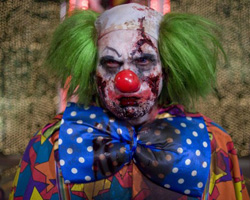 8) Zombieland
8) ZombielandWhy it's on the list: Two words: Bill Murray. Why you might be saying "Oh, hell no!": The movie gave you the munchies for Twinkies. --Zombieland is, without a doubt, just about the funniest freaking zombie film ever made. And I don't mean "oh, wasn't that clever?" funny; I mean laugh-out-loud, slap-your-knee, belly-laugh funny. Which, unless you're making an out-and-out spoof, is not that easy to do. Probably the biggest component in Zombieland's success in this regard is it doesn't take itself, or its genre, too seriously. That's not to say Zombieland doesn't have its serious moments, or its moments of pure horror. It does, and it plays straight with the audience in those scenes; it just doesn't get hung up on itself during the long stretches in between. Another reason for the film's success is its economy of script: the only backstory is delivered during the opening credits, courtesy of the voiceover by our first protagonist. Before we're more than ten minutes into the film, we're told all we need to know about what's happened and how, and why our nerdy narrator has managed to survive. By the time we meet the remainder of the non-living dead cast, we've gotten a good sense of the world they inhabit, and had a goodly bit of action to get us in zombie-film mode. But Zombieland never lets up on the humor, for all its moments of genuine nail-biting, edge-of-your-seat horror. You'll laugh at least as often as you jump, you'll be amazed at how quickly the film has flown by, and you'll even shed a tear or two during those rare moments when Zombieland shows you its heart. Zombieland is a flat-out E ticket ride of a film, with more life (pardon the pun) and joy than many a movie, horror or not, and you can't say fairer than that. Oh, and whoever came up with the idea of displaying the rules on-screen? Genius! (Stephanie Star Smith/BOP) --Zombieland is actually a pretty odd duck, and I'm somewhat surprised it turned into a modest hit. More indie character study than gruefest, the film spends as much time on back story and road movie machinations as it does on gut-munching. Woody Harrelson is excellent as Twinkie-loving Tallahassee, a redneck survivor of the zombie apocalypse who meets up with nerdy Columbus (Jesse Eisenberg) on the Texas to Ohio highway. The two are diverted to California after getting carjacked by femme fatales Wichita (Emma Stone) and Little Rock (Abigail Breslin) and end up rubbing shoulders with Bill Murray in hilarious fashion. Kudos to Columbia for a brilliant marketing strategy, which played up the film's comedic elements without giving away all the best bits in advance. (John Seal/BOP) --Comedy and horror are an uneasy mix. As laughing is by definition a release of tension, trying to mix in scares is going to automatically strip out most of the spooky mood you're trying to achieve. The trick, then, if you're trying this, is to find those moments in your film where characters can be funny without popping the balloon on yourself, as well as finding the right setting. Zombie films, especially slow zombies, provide ample space for that, as Zombieland proves admirably. Its four survivors of a zombie plague all occupy four different archetypes of post-apocalyptic films – lone nut, loner intellectual, femme fetale and plucky kid. Zombieland runs them through a cross-country quest. What marks the film is its seemingly endless creativity with regards to dispatching the undead that come between the four of them and their goals – banjos, car doors, pianos, guns if they absolutely have to – and its cleverly thought out description, complete with rules, on just how one would survive the zombie apocalypse. If you're looking for hardcore scares, this isn't really the film for you – though there are shocks to be had – but if you're looking for a consistently inventive and thoroughly hilarious take on the end of the world, there's no place else to look. (Reagen Sulewski/BOP) --Hi, I am the only movie critic in North America who listed Zombieland as the best movie of 2009. This is not the first time I have fallen victim to such a fate. I am now more convinced than ever that I was right when I did this with The Bourne Identity in 2002 and Serenity in 2005. I am a fervent believer that an impartial evaluator should not select a title as their favorite simply because it falls into some expected category or makes them sound well educated on cinema. There is an insecurity in such behavior and the process should not work like that. All I ask from a new feature is for it to be good and worth the opportunity cost of time and (occasionally) money I invest in it. Zombieland clears this particular hurdle like few films ever have. What all three of these titles have in common is that the first time I watched each one, I was blown away. When I re-watched them, however, I was even more impressed by the fact that each title held up just as well on repeated viewings. That means the jokes are clever enough to be repeatable and the action sequences are noteworthy enough to grab my eye when I am working and have the television on for background noise. With regards to Zombieland, I am in awe of how many sequences from the film catch my attention. The scene where our "hero" has his first date with his hot neighbor is engaging. The amusement park shootout is hysterical and even a bit tense. The introduction of the men to the sisters is a genius misdirect. And I have a very difficult time choosing which of two moments is my favorite, the introduction of Tallahassee or the visit to the Hollywood mansion of a movie star. I'm inclined to say the latter since we all know by now how that ends and why it's the funniest bit in 2009 cinema. Even so, I am indescribably attached to that one bit of sublime character development that introduces Tallahassee, that Dale Earnhardt #3 on the side of his vehicle. And I don't even like Nascar. Over the past year, Zombieland has quickly become one of those litmus test movies for me wherein if you like it, you and I will be fast friends and if you don't, you are my sworn enemy for life. I am just that attached to it. While Zombieland didn't get my first place vote (there is a film I find much scarier that finishes in the top five), this is my favorite movie of all the titles on our newest horror list. (David Mumpower/BOP) Zombieland Trivia Quiz |
|
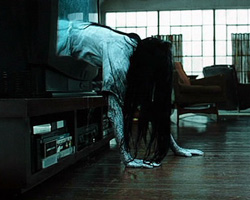 7) The Ring
7) The RingWhy it's on the list: The flickering ghost person got played out over time, but this was the original (well, this and Ringu) and it did it really well. Why you might be saying "Oh, hell no!": What's a videotape? --Like The Skeleton Key, The Ring was written (or, at least, co-written) by Ehren Kruger, a dude who has an incredibly fortunate name when working on Hollywood horror movies. (He's also done Scream 3 and The Ring Two). Anyway, The Ring deserves some play on BOP's favorite horror movies list because it marks what I think to be the rare instance when Hollywood got it right. That is, it took a idea already made into a movie and re-imagined it, successfully, for American audiences. Usually, Americanizing means bigger budget, bigger names and increased death counts. (You know, the American way!) Yet besides the first point – The Ring was made for about $48 million – the film doesn't follow the typical "Hollywood remakes a movie" template. Naomi Watts wasn't a household name by that point. Save for Mulholland Dr., her bigger movies – 21 Grams, King Kong – didn't hit theaters until after the release of The Ring. And who would you say co-starred with her? Daveigh Chase? David Dorfman? They were 12 and 9, respectively, when The Ring hit theaters. Brian Cox is in it, too, but played more cameo than anything. After an opening scene that plays like homage to Scream, The Ring unfolds slowly. It's a mystery, and Gore Verbinski takes his time in giving us answers. It's not like The Ring's sole objective is to introduce a killer and have her, you know, kill people. It's all about finding out the young girl's motives, and what has made her so unhappy. Some movies may be all thrills in round one, and then save the origins story for the sequel. The Ring, however, did both. (Eric Hughes/BOP) --The Ring blasted off in October 2002 with a respectable $15 mil opening weekend. Seven days later, the film saw an increase of 23.1% in Weekend #2 to $18.5 mil. It dropped a mere 2% in Weekend #3, and eventually finished with a domestic total of $129 mil, or more than 8.5 times its opening weekend gross. Now how many horror films not named Paranormal Activity can you think of that boasts a box-office performance as impressive as that? Clearly, it would be an understatement to say that The Ring is not your typical horror film. Its tremendous reception ushered in a wave of Asian horror remakes, some successful (The Grudge) and some not (Dark Water, Pulse, The Eye, The Grudge 2, etc.). But while The Ring's Asian-remake progeny haven't been all that pleasant to sit through (see above: non-successful films), there are a number of reasons why The Ring found itself such a eager audience back in 2002, and why it now finds itself in BOP's list of Favorite Horror Films. For my tastes, The Ring combines the best elements of the American and Asian horror genres, which results in a thoroughly unnerving two-hour moviegoing experience. It has the horrifying and utterly un-anticipatable initial scare, which puts a viewer on the edge of their seat, knowing that another unforeseen terror could appear at any time. It has long patches of unsettling atmospheric tension, a tactic mastered by Asian horror directors. Finally, it has one deliciously-cheesy-and-yet-somehow-also-terrifying climactic sequence in which the "villain" finally reveals herself. It's an iconic scene and, I believe, one that will be long remembered. The Ring is without a doubt the scariest film I have seen in the last ten years and I have no desire to sit through it again. Of course, if you're interested in seeing it, I have a videotape that I'm willing to lend you... (Jason Lee/BOP) The Ring Trivia Quiz |
|
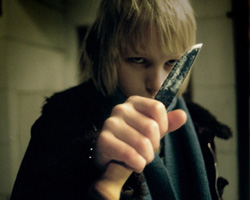 6) Let The Right One In
6) Let The Right One InWhy it's on the list: We always wanted a friend who would kill for us. Why you might be saying "Oh, hell no!": You saw the version with the bad subtitles. --There's a reason why none of the Twilight films will be showing up on lists of the BOP Staff's favorite horror films, and it's because we like our vampires to be terrifying rather than mopey, and to suck blood rather than brood over Kristen Stewart. Is it any surprise, then, that we loved Let the Right One In, one of the most interesting vampire films in recent years? Coming out of Sweden, this film is at times shocking, disturbing, and deeply moving. This youthful perspective of the film is fascinating, because children tend to be much more open-minded than adults do. John Lindqvist's screenplay, which he adapted from his own novel, respects the ideas and emotions of its youthful protagonist, which gives the film its emotional resonance, and Tomas Alfredson's superb direction creates a chilling atmosphere that immediately draws you in. And of course, the performances make the movie, with Lina Leanderson giving a superb performance, not just considering her age. The maturity we see in her is breathtaking, and is part of what assures Let the Right One In a place on the list of the best vampire films of all time. (Tom Houseman/BOP) --I wonder if, with the right push, and enough time, this could have been a crossover foreign-language smash on the level of Crouching Tiger, Hidden Dragon. Tomas Alfredsson, working off an adaptation by John Ajvide Lindqvist from his own novel, crafts a tale that, before it is a tragic kind-of-love story, before it is a revenge tale, before it is even a vampire saga, is a chilling dissection and brutally honest assessment of growing up with no future in the middle of nowhere. The perpetually frozen snow, the bone-chilling cold, the older generation given over to alcoholic nostalgia, are all etched as a backdrop to the action and terror even as the story progresses. Never has the dead of night felt both so terrifying and completely empty. Moments of bleak, dark humor, stylish violence and one unexpected shot cribbed from The Crying Game feel earned rather than gratuitious and mark Alfredsson as a director to watch. (Brett Beach/BOP) --What makes most great horror films so scary is the unseen. Jaws, while being the forerunner of the Hollywood blockbuster, stands up today because of how infrequently we see the shark that's laying a bloody swath throughout the town of Amity. Let the Right One In, the Swedish film based on a popular novel, is one such horror film that knows to show as little as possible. As with any vampire film, there is plenty of blood here. However, the most memorable shot in the film - for those who've seen it, I'm talking about a shot right near the end, set in a pool - manages to feature plenty of gore while keeping it far in the background. Let the Right One In is a great horror film, but it's also a great drama, an exploration of young love and friendship, the frustrations of being bullied, and how our relationships with people make us do baffling, silly, and sometimes dangerous things. Much of Let the Right One In, set in a small town outside Stockholm in the 1980s, is about atmosphere. The world of the film is alien, from the constant ice and snow, to the interactions between family and friends. Once Eli, the little girl befriend by the film's main character Oskar, is revealed to be a bloodsucker, it comes as less of a shock and almost something of a product of the time and place. Unlike most horror movies, Let The Right One In is patient, never attempting to make cheap thrills. The remake of the film, Let Me In, has been well received but is dying at the box office. If you think liking only movies such as Saw makes you a horror fan, steer clear, but if you know that there are different ways to be freaked out by movies, Let The Right One In is sure to give you chills. (Josh Spiegel/BOP) --Ignored, remade, and largely ignored again, such is the life of the unique and daring horror film. A truly rare breed. But you don't get to become a beloved cult movie if you blow up the box office, now do you? It's easy to see why yet another vampire themed story would fly under the radar of many who enjoy the genre. Dependent mostly on the peculiarities of the challenging relationship between the creature Eli and the young boy Oskar, there isn't much violent action or gruesome effects. The chill in the air isn't just from the snowy small town setting, it's that you're witness to the ugly requirements of what it takes to be either an outcast at school or of society at large. But what ends up happening on screen in the midst of bullying and murder is one of the most romantic and risky love stories ever told in horror since perhaps that of Hannibal and Clarice. (Qale/HWDYK) Let the Right One In Trivia Quiz Read the Bride of Horror List Introduction Read selections 25-16 See selections 5-1 |
|

|
|
|

|
Thursday, October 31, 2024
© 2024 Box Office Prophets, a division of One Of Us, Inc.

